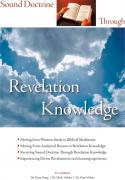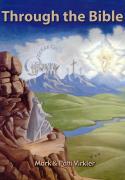Question from a Searching Pastor: Several in my congregation have asked, “Where in the Scriptures are we told to ‘picture’ or visualize Jesus, since both 2 Corinthians 5:6, 7 and 1 Peter 1: 7, 8 say that we don’t see Jesus?" Obviously Hebrews talks about "'fixing our eyes on Jesus" but what does that mean? Any advice you can give will be much appreciated.
Answer from Dr. Gary Greig and Dr. Mark Virkler
 Seeing Inwardly Versus Seeing Outwardly
Seeing Inwardly Versus Seeing Outwardly
As you read the context of 2 Corinthians 5:6-7 and 1 Peter 1:7-8 you will note they are both talking about PHYSICALLY SEEING - seeing PHYSICAL CIRCUMSTANCES (2 Cor 5:6-7) and PHYSICALLY SEEING JESUS (1 Pet. 1:7-8). When it comes to seeing with the eyes of our hearts, Paul tells us to look and see the glory of the Lord in the "unseen" world (2 Cor. 3:18; 4:18) and Hebrews 12:2 tells us we are to be fixing our eyes on Jesus.
Paul tells us that we all, with unveiled face, beholding as in a mirror the glory of the Lord, are being transformed into the same image from glory to glory, just as from the Lord, the Spirit (2 Cor. 3:18). One chapter later, Paul confirms that this transformation occurs “while we look not at the things which are seen, but at the things which are not seen (2 Cor. 4:18).”
So the question is: What (or Who) is it in the unseen realm that we are to look at and, that by beholding, will transform us into the same image?
The answer: As I look with the eyes of my heart to see what Jesus is doing in the situation, and I take on His actions by saying, “Yes, Lord.” and do what I see Jesus doing, the result is that I am transformed from a person who does something out of self, to a person who is doing what I see Jesus doing in the situation.
For example, I want to hit someone (maybe just with words, but I want to hit them as they have made me frustrated). But when I look into the spirit world to see how Jesus is reacting to the person, the picture that lights upon my mind is Jesus ministering grace to them. So I decide to minister divine grace to them as well. I decide to do what I see Jesus doing, and thus I have been transformed while I looked into the unseen realm, with the eyes of my heart, and observed the actions of Jesus and said "yes" to what He was showing me He was doing.
Seeing Jesus' Present Tense Movements
This is taking us one step beyond the book "In His Steps" by Charles Sheldon where he asked, “What would Jesus do?" We ask instead, “What is Jesus doing?” Since Jesus is still alive, and is Immanuel, God with us, and is still doing things, there is no need to make this a past tense or hypothetical question. It is a present tense question. Jesus is still moving and we still have eyes in our hearts that function and can see visions and dreams!
Abiding in Christ Involves Seeing Jesus
This is the way Christians are to live all the time. It is called “abiding in Christ” (Jn. 15) and it involves hearing, feeling, sensing and seeing Jesus in action, the One Who is walking with us down the road of life. It is simple. It must be simple enough for a child to do (Lk. 18:17), so don't make it difficult. It is asking the Holy Spirit to show you what Jesus is doing, and then looking with the eyes of your heart into the unseen world, and honoring and accepting and believing the pictures that light upon your mind while you are in that poise. You have asked for them to come from the Holy Spirit and Jesus' promise is that indeed they do (Jn. 7;37-39; Lk. 11:13). So go ahead and accept them in simple childlike faith. Of course they need to be compatible with Scripture and it is always wisest to submit them for confirmation to your 2-3 spiritual advisors (Matt. 18:16), especially when involving any significant decisions or if you are uncertain about what you have received.
When King David Meditated, He Used the Eyes of His Heart
Notice how King David used the eyes of his heart to “see” the Lord when he was meditating. For example, Psalm 63 associates meditating (Hebrew hagah) with seeing in the Spirit a vision from God (Hebrew khazah).
“I have seen (khazah) You in the sanctuary and beheld Your power and your glory (Ps. 63:2).” And four verses later: “When I remember You on my bed, I meditate on (or ‘imagine’ hagah be) You in the night watches (Psa. 63:6).” So for King David, meditating absolutely included seeing in the Spirit realm. When we meditate, we must also be presenting the eyes of our hearts to the Holy Spirit, asking Him to show us God’s visions (Acts. 2:17).
In Ps. 16:8 David also indicates he uses vision as he walks down the road of life: “I have set the LORD always before me; because He is at my right hand I shall not be moved.”
I would say, King David is picturing the Lord before him, at his right side. I can think of no reason not to do this. The Bible says Jesus is Immanuel God with us, so why limit ourselves to just thinking it? Why not picture it? If a picture is worth 1000 words then what we see has much greater power to impact us than what we hear, probably because we have stepped from mind to heart. I assume that is why Jesus always painted pictures when he spoke (Matt. 13:34). He was communicating heart to heart the truths about a heart to heart relationship with Almighty God.
Exploring the Precise Hebrew Definition of Meditation
Let's look at the meaning of the Hebrew verb hagah "meditate, imagine, visualize," in Joshua 1:8 and Psalm 1:2. As we will see in the paragraphs that follow, the standard Hebrew lexicon, Brown, Driver, Briggs, and Spanish Old Testament & Hebrew scholar, Dr. Jesus Arambarri, have proven the meanings "imagine" and "visualize" for this verb in the Hebrew Bible.
The other passages in the Hebrew Bible that demonstrate the "imagine"/"visualize" meaning are discussed in detail on pages 7-13 of How to Release God's Healing Power Through Prayer by Greig, Virkler and Gaydos. ![]()
The paragraph below is a summary of the commands to imagine and visualize God's Word (as taken from pages 7-13 of the above book). Visualizing is not a New Age idea: it's a godly, heavenly idea that satan stole and counterfeited!! And the Hebrew hagah in Joshua 1:8 and Psalm 1:2 (and all the other passages in the Hebrew Bible where it is used) prove it!
Summary: God commands us in Joshua 1:8 and Psalm 1:2 to exercise our godly imagination by meditating on and imagining what God says is true in the Scriptures. [17] For Joshua and the Israelites this meant imagining and picturing the great acts of God in Israel’s history and imagining themselves obeying the laws described in the Book of the Law mentioned in Joshua 1:8 and Psalm 1:2. Spanish Old Testament scholar, Dr. Jesus Arambarri, did a careful syntactic and semantic study of the Hebrew verb hagah and the verbal phrase hagah be which is used in Joshua 1:8 and Psalm 1:2.[18] He concluded that when the verb is used of the heart to denote meditating, it denotes “more than just speaking.”[19] Hebrew hagah be in Joshua 1:8 and Psalm 1:2 refers to a type of reflection that envisions or pictures God’s deeds (“the envisioning [vergegenwärtigend] memory of Yahweh’s acts of salvation”).[20] He adds that Hebrew hagah be “has to do with a joyful and willing preoccupation with the past, which, in the course of remembering, has come to be in the present. . . . ‘Reflect, meditate’ are common translations. . . . Hagah be comprises a thinking, a repeating, a putting of oneself in the original mind-set.”[21] When one envisions or pictures what the Scriptures describe and one puts oneself in the original mind-set of those who witnessed the saving acts of God, “the past of salvation history becomes the present in the outlook of the person, who remembers the deeds of the Lord, [and] who carries the Torah in his heart.”[22] Concerning Joshua 1:8, Dr. Arambarri concludes, “The visualizing [Vergegenwärtigung] of the deeds of God—this occurs in Josh. 1:8 with the continuous keeping-in-the-mouth of the written words, which are found in the Book of the Law.”[23]
Dr. Arambarri points to several other passages in the Hebrew Bible, besides Joshua 1:8 and Psalm 1:2, which prove that the Hebrew verb hagah meant not only to meditate verbally by “muttering” and “speaking,” but also meant to “imagine,” “devise (in the mind),” or “visualize/ visually ponder,” in passages like Psalm 63:6; Prov. 24:2; Isa. 33:18.
Thus these passages above show that in the Old Testament the biblical concept of meditation involves pondering that imagines, visualizes, and pictures the Lord, people, and events. For this reason Dr. Arambarri concluded that in Joshua 1:8 and Psalm 1:2 the concept of meditating on the Scriptures (the Torah) include visual pondering, imagining,and picturing the past heroes of the faith and the past acts of the Lord in salvation history described in Scripture.
The visual pondering aspect of meditation in Joshua 1:8 and Psalm 1:2 was understood well in the New Testament, not only by Peter in Acts 2:25, but also by the epistle of James, which echoes the same theme of visual pondering in James 1:25. The OT concept of meditating on God’s law is expressed in James 1:25 as visually looking into God’s law with “penetrating absorption.”[28] The Greek participle parakupsas in James 1:25 denotes “one who bends over” or “one who looks into”[29]: James 1:25 “But the one who looks intently into (Grk. parakupsas) the perfect law that gives freedom, and continues to do this, not forgetting what he has heard, but doing it--he will be blessed in what he does.”
Conclusion:
This is why we conclude that practicing biblical meditation means visually pondering and picturing what God says is true in Scripture, while we keep the words of Scripture in our mouths, memorizing key passages.
Footnotes:
[17] The Hebrew verb “meditate on” (hagah be) includes the connotations “imagine” and “devise (in the mind)” according to a standard Hebrew lexicon, F. Brown, S. R. Driver, and C. A. Briggs, A Hebrew and English Lexicon of the Old Testament (Oxford: The Clarendon Press, 1951), p. 211, right column sub hagah. For example, Psalm 63 associates meditating (Hebrew hagah) in Psa 63:6 with seeing in the Spirit a vision from God (Hebrew khazah) in Psa 63:3--Psa. 63:3 “I have seen (khazah) You in the sanctuary and beheld Your power and your glory” . . . Psa. 63:6 “When I remember You on my bed, I meditate on (or ‘imagine’ hagah be) You in the night watches.” See the notes below: Hebrew hagah be also connotes “visualizing” or “picturing” the mighty acts of salvation history in Scripture, according to Dr. Jesus Arambarri in A. A. Diesel et al., eds., Jedes Ding Hat Seine Zeit: Studien zur Israelitischen und Altorientalischen Weisheit [Festschrift D. Michel] (BZAW 241, Berlin: Walter de Gruyter, 1996), pp. 1-17.
[18] Ibid.
[19] “As an activity of the heart (Prov. 24:2), it is more than just talking or speaking” (“Als Tätigkeit des Herzens (Prov. 24,2) ist es mehr als ein Reden oder Sprechen.” Arambarri, in A. A. Diesel, Jedes Ding Hat Seine Zeit, p. 10).
[20] “Das vergegenwärtigende Gedenken an Jahwes Heilshandeln.” Arambarri, in A. A. Diesel, Jedes Ding Hat Seine Zeit, p. 12.
[21] “Es handelt sich um eine freudige und willige Beschäftigung mit einer Vergangenheit, die im Laufe des Gedenkens zur Gegenwart geworden ist. . . . “Nachsinnen, meditieren’ sind geläufige Übersetzungen. . . . Hagah be beinhaltet ein Denken, ein Wiederholen, ein Sich-auf-die-entstehende-Stimmung-Einlassen.” Arambarri, in A. A. Diesel, Jedes Ding Hat Seine Zeit, p. 14.
[22] “Die Vergangenheit der Heilsgeschichte wird Gegenwart in der Haltung des Menschen, der sich an die Taten des Herrn erinnert, der die Torah im Herzen trägt.” Arambarri, in A. A. Diesel, Jedes Ding Hat Seine Zeit, p. 16.
[23] “Die Vergegenwärtigung der Taten Gottes, das geschieht in Jos 1,8 mit dem ständigen Im-Mund-Behalten der geschriebenen Worte, die im Buch des Gesetzes zu finden sind.” Arambarri, in A. A. Diesel, Jedes Ding Hat Seine Zeit, pp. 14-15.
[24] The Hebrew verb khazah is frequently used in the Hebrew Bible to denote seeing a vision from God or seeing in the spiritual realm: khazah “see (a vision),” Brown, Driver, and Briggs, A Hebrew and English Lexicon of the Old Testament, p. 302 right column; Koehler and Baumgartner, The Hebrew and Aramaic Lexicon of the Old Testament, vol. 1, p. 301 left column.
[25] For discussion on the Hebrew verb khazah denoting prophetic, visionary seeing in the spiritual realm in ancient Israel, see the classic work of R. R. Wilson, Prophecy and Society in Ancient Israel (Minneapolis, MN: Fortress Press, 1980), pp. 140, 254-256; F. Haeussermann, Wortempfang und Symbol in der alttestamentlichen Prophetie (BZAW 58; Giessen, 1932), pp. 4-5; R. Rendtorff, “Prophetes: nabi’ in the Old Testament," in Kittel,Theological Dictionary of the New Testament, vol. 6 (1968): p. 809; M. Jastrow, “Ro’eh and Hozeh in the Old Testament,” Journal of Biblical Literature 28 (1909), pp. 42-56; H. M. Orlinsky, “The Seer in Ancient Israel,” Oriens Antiquus 4 (1965), pp. 153-174; R. Kraetzschmar, Prophet und Seher im alten Israel (Tübingen: J.C.B. Mohr, 1901), pp. 19-25.
[26] Samuel Meier, Themes and Transformations in Old Testament Prophecy (Downers Grove, IL: InterVarsity Press, 2009), p. 43 and note 4: “This designation ‘seer’ is typically applied to individuals who are capable of seeing things that normal people cannot. . . . In fact this special gift of sight does not even require normal vision, as the experience of the blind prophet Ahijah makes clear when an individual tries unsuccessfully to disguise her identity from him (1 Kings 14:1-6). . . . Compare also blind Greek seers. . . . Versions of their stories in which the gift of prophecy, in essence a second sight, is a consequence of their blindness make it arguable that their special sight beyond the physical realm would probably be compromised if they had normal vision.” [Emphasis ours]
[27] J. N. Oswalt, Isaiah 1-39 (Grand Rapids, MI: Eerdmans, 1986), p. 603.
[28] W. Michaelis, in Kittel, Theological Dictionary of the New Testament, vol. 5, p. 815.
[29] BDAG [W. Bauer, F. W. Danker, W. F. Arndt, F. W. Gingrich, A Greek-English Lexicon of the New Testament and Other Early Christian Literature (Chicago: The University of Chicago, 2000)],, p. 767, right column; cf. the earlier edition definition in Bauer, Arndt, Gingrich, and Danker, A Greek-English Lexicon of the New Testament and Other Early Christian Literature (Chicago: University of Chicago Press, 1979), p. 619.
"Meditate" - Strong’s Exhaustive Concordance Number: H1897 (hâgâh (
Total Number of Occurrences in the King James Bible is 24, and It Is Translated as Follows:
- Meditate (6) Jos_1:8, Psa_1:2, Psa_63:6, Psa_77:12, Psa_143:5, Isa_33:18
- Mourn (4) Isa_16:7, Isa_38:14, Isa_59:11, Jer_48:31
- Speak (3) Psa_35:28, Pro_8:7 (2)
- Imagine (2) Psa_2:1, Psa_38:12
- Studieth (2) Pro_15:28, Pro_24:2
- Mutter (1) Isa_8:19
- Muttered (1) Isa_59:3
- Roaring (1) Isa_31:3-4 (2)
- Speaketh (1) Psa_37:30
- Talk (1) Psa_71:24
- Utter (1) Job_27:4
- Uttering (1) Isa_59:13
Blogs On Meditation and Using the Eyes of Your Heart as You Approach God
- How to Meditate on Scripture & Receive Life-Transforming Revelation
- Hebrew and Greek Definitions of Meditation
- Western Study Versus Biblical Meditation
- 7 Step Meditation Process Explored
- 7 Step Meditation Bookmark (shown at right)
- Healing Scriptures for Meditation
- 4 Keys to Hearing God’s Voice
- What Does the Bible Teach about Visualization?
- You Can See Visions! They Are a Pathway to God
- Poised Before Almighty God
- Lord, When Is “Priming The Pump” Acceptable and Unacceptable?
- Initiative - Should I Take It? by Charity Kayembe
- Help! I Have Trouble Seeing Vision!
- Protestantism's 500-Year-Old Bitter Root Judgment and Inner Vow (a chance to repent)
- Training Your Child to Encounter Jesus - Godly Imagination & Visions
- How to Receive Revelation Knowledge
Books And Courses On Meditation And Spiritual Formation
- Hearing God Through Biblical Meditation book
- Meditation: How to Study the Bible in the Presence of God ebook
- The Art of Biblical Meditation Interactive Online Course from School of the Spirit
- Training Package - 4 Keys To Hearing God's Voice (One key is to use vision)
- Training Package - Hear God Through Your Dreams (Dreams utilize imagery)
- Book - Am I Being Deceived? (Difference between New Agers and Christians)
- Book - Secret Place (Examples of God painting beautiful scenes during prayer times)
- Divine Healing Toolbox CD/DVD Set (using vision while praying for healing)
- Training Package - Prayers That Heal the Heart (Inner healing prayer utilizes vision)
- Sound Doctrine Through Revelation Knowledge by Mark and Patti Virkler – an alternative to traditional hermeneutics.
- The Great Mystery – Christ in You by Mark and Patti Virkler – Explores all New Testament verses that describe what Jesus provides for you through His indwelling Spirit.
- How to Walk by the Spirit by Mark and Patti Virkler – Explores Scriptures concerning the heart
- Intimacy with the Holy Spirit by Mark and Patti Virkler– Explores Scriptures concerning the Holy Spirit
- How Do You Know? by Mark and Patti Virkler – Explores hundreds of verses which reveal God’s prescribed methodology for discovering truth.
Related Resources:
How to Master Your Bible!












Add new comment